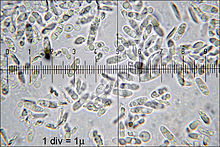Lion's Yellow Stalk Porling
| Lion's Yellow Stalk Porling | ||||||||||||
|---|---|---|---|---|---|---|---|---|---|---|---|---|

Lion's Yellow Stielporling ( Cerioporus leptocephalus ) |
||||||||||||
| Systematics | ||||||||||||
|
||||||||||||
| Scientific name | ||||||||||||
| Cerioporus leptocephalus | ||||||||||||
| ( Jacquin ) Zmitr. |
The Löwengelbe Stielporling or Löwengelbe Schwarzfußporling ( Cerioporus leptocephalus , Syn . : Polyporus leptocephalus , P. varius ) is a type of fungus from the family of the Stielporlingsverwandten . It owes its name to the mostly striking yellow ocher hat color.
features
The fruiting bodies of the lion's yellow stem porling are divided into a hat and a stem . The hat is 3–10 (–20) cm wide and often deepened in the middle like a funnel. The mostly dull and bald skin of the hat is colored pale gray-yellow to reddish ocher yellow ("lion yellow"). The tube layer is thin at 0.5–2 mm. When young, it later darkens from cream to ocher or gray-brown. The pores are very fine (4-6 per mm) and run far down the stem. The stem, which has grown from the center to the side of the hat, can only be short or even absent. The stem bark is smooth, matt and colored cream to brownish or ocher. The stem, blackened from the base, is typical. The blackening extends up the stem to different degrees: in some specimens only the base of the stem is colored, in others the blackening extends to the base of the hat.
Species delimitation
The differentiation from other black- footed stem porlings of the genus Picipes is sometimes difficult. The chestnut-brown stem porling ( P. badius ) is microscopically characterized by buckle-free hyphae and is clearly distinguished by its red-brown, greasy, shiny hat. The rarer black-footed stalk porling ( P. melanopus ) can look very similar, but has a brown hat, a long, irregularly longitudinally grooved stem and mostly apparently grows on the ground. The spores are also a bit smaller. The also rare Picipes tubaeformis has a funnel-shaped hat that becomes maroon when old.
ecology
The Lion's Yellow Stielporling is a saprobiontic wood dweller that causes white rot on fallen, barked and barked branches. In wetter locations it also colonizes branches and twigs of dead, still standing trees. According to Jahn, the species can also grow parasitically on living apple trees. In Central Europe, the main substrate is red beech , besides a wide range of other hardwoods, very rarely coniferous wood, is populated. In Northern Europe it switches to poplars and willows . The fungus is found mainly in beech and beech fir forests, but can also be found in other types of forest, gardens, parks, hedges and in cemeteries.
The mushroom can be found all year round in Central Europe. Young fruiting bodies appear mainly in early summer, sometimes as early as May.
distribution
The species is native to Asia, North America (to Alaska) and Europe in all countries, north to Iceland and the Hebrides, in Norway up to the 70th parallel. It is relatively common in Germany, especially in the low mountain ranges with a high proportion of beech trees.
Systematics
The taxa " Polyporus nummularius " (small, centrally-stalked fruiting bodies on thin, fallen branches) and " Polyporus elegans " (medium-sized, laterally-stalked specimens on thicker branches) are no longer considered to be separate species and are used as substrate forms of Lion's yellow stem porlings viewed.
meaning
The Lion's Yellow Stielporling is not an edible mushroom, as a wood destroyer it is not of forestry importance.
swell
- Josef Breitenbach, Fred Kränzlin (Ed.): Mushrooms of Switzerland. Contribution to knowledge of the fungal flora in Switzerland. Volume 2: Heterobasidiomycetes (gelatinous mushrooms), Aphyllophorales (non-leaf mushrooms), Gastromycetes (belly mushrooms). Mykologia, Luzern 1986, ISBN 3-85604-020-X .
- German Josef Krieglsteiner (Ed.): The large mushrooms of Baden-Württemberg . Volume 1: General Part. Stand mushrooms: jelly, bark, prick and pore mushrooms. Ulmer, Stuttgart 2000, ISBN 3-8001-3528-0 .
- Ewald Gerhardt: FSVO manual mushrooms . 3. Edition. BLV, Munich 2002, ISBN 978-3-405-14737-2 (639 pages; one-volume new edition of the BLV intensive guide mushrooms 1 and 2).



